From Science-Based Medicine: The Top Ten Pet Supplements–Do They Work?
An Embarrassment of Riches?
Much has been written here about the dietary supplement industry, a multibillion dollar industry with powerful political connections, and about the woeful inadequacy of regulation which allows widespread marketing of supplements without a solid basis in science or scientific evidence.
The veterinary supplement market is a pittance compared to the human market, but still a billion-dollar pittance that is growing rapidly. Unfortunately, the resources available for good quality research in veterinary healthcare are also a pittance, and it is not at all unusually for our pets to suffer, or even be euthanized, as a result of treatable diseases for want of money to pay for needed care. So $1 billion a year spent on nutritional supplements may not be such a good deal if these products don’t effectively prevent or treat disease.
The variety of supplements available is staggering. Many proprietary concoctions of vitamins, minerals, herbs, and other ingredients are marketed for health maintenance, “boosting the immune system,” retarding aging, or treating specific diseases. A comprehensive review of this multitude of moving targets is impossible. But the lion’s share of the pet supplement market goes to a few specific compounds, so I will focus on these. Most of these ingredients are also among the most popular supplements for humans, with a few exceptions, so there will be substantial overlap with previous discussions of the plausibility and evidence for many of these substances.
1. Glucosamine
The biggest name in the veterinary supplement world by a large margin is glucosamine. It is sold alone or in combination with chondroitin, MSM, green-lipped mussle extract, and a zillion other ingredients. It is sold over-the-counter and through veterinarians and as an additive in commercial pet foods, and it is ubiquitous. It is also widely believed by pet owners and veterinarians to be an effective treatment for osteoarthritis.
Glucosamine for arthritis in humans has been discussed at length here before. There is some reasonable plausibility to the underlying theory, but decades of clinical trials have failed to find any consistent benefit, and the balance of the evidence strongly suggests it is no better than a placebo in treating arthritis in humans. Given the subjective nature of pain and the multitude of ways biologically inert interventions can influence people’s perceptions of their own discomfort, this placebo effect might be of marginal value in humans, but the same kind of psychology does not apply to dogs and cats, though it certainly does apply to their owners.
There is very little clinical research on glucosamine as a treatment for arthritis in dogs and cats. In preparing a recent brief literature review, I found only two clinical trials in dogs. One found no benefit for glucosamine and the other, which had a weaker design, showed little benefit. Both showed far greater and more predictable benefit to non-steroidal anti-inflammatory (NSAID) therapy, which is a consistent feature of clinical research on glucosamine.
Because cats are poorly tolerant of NSAIDs, there is particularly great interest in glucosamine and other nutraceutical therapies for osteoarthritis in this species. Nevertheless, I have found no published clinical trials studying this supplement in arthritis cats. The closest is a study of a diet containing glucosamine, chondroitin, and a number of other supplements purported to have benefits in managing arthritis. I have addressed this study in detail elsewhere, but in brief there were not consistent differences between the experimental diet and the control diet even on subjective measures of comfort and no differences at all on objective measures of activity. And, of course, the role of glucosamine, if any, in any effect that might have been seen would not be demonstrable in a study of a diet with many other ingredients.
Glucosamine is also marketed for treatment of feline interstitial cystitis, an uncomfortable and potentially very serious chronic inflammatory disease of the urinary bladder. However, the only clinical trial to investigate this use did not find any evidence of benefit.
2. Fish Oil
After glucosamine, one of the most popular supplements for pets is fish oil. In humans, the most common use of this supplement is for lowering blood lipid levels and prevention of cardiovascular disease. There is some controversy about exactly how much of which components is useful for which specific conditions, and whether eating fish is better than taking fish oil supplements, but in general there is good evidence for some benefit in cardiovascular disease prevention.
Cats and dogs don’t have the problems humans do with atherosclerosis and cardiovascular disease, so this is not a reason for use of fish oils. Instead, this supplement is most commonly used in the treatment of skin allergies. A 2010 narrative review of the evidence for various approaches to treating canine skin allergies concluded that there was some evidence that fish oil supplements can improve coat quality and reduce the dosage of steroid medications needed to control itching, but that these effects are small and not great enough to substitute for other therapies. There is also not evidence to support the use of any particular source, dosage, or formulation of fish oil over any other.
The other common use of fish oils in pets is for treatment of arthritis. There is weak evidence in humans for the use of fish oil supplements as an adjunctive treatment in patients with rheumatoid arthritis, but in general this is not a well-supported intervention for degenerative osteoarthritis in people. There have been several studies of fish oil as a therapy for osteoarthritis in dogs, which I have reviewed in detail (here and here). These are pretty well-designed studies, all by the same group of investigators, and as is common for studies of dietary supplements, they report mostly negative results but then focus on the few statistically significant findings, generally with subjective measures, to conclude the studies are proof of a benefit. The idea that fish oil supplements might have some small benefit for arthritis in dogs and cats is not out of the question, but so far the evidence is not encouraging.
3. Probiotics
Mark Crislip has eloquently addressed the theory and science of probiotics for humans, and the bottom line for pets appears to be much the same. We understand very little about the important and complex ecology of the gastrointestinal tract, about what bugs are there and what they do for or to us. So while the idea of influencing this flora to restore or maintain health makes some sense, adding a few Lactobacillus to the mix and expecting it to have a major effect seems a bit like tossing a few grass seeds into the Amazon rain forest and expecting a golf course to grow there (thanks Mark!).
Clinical studies in humans support some benefits for some conditions, particularly antibiotic-associated diarrhea, but many of the claims made for probiotic products, especially for health maintenance or “boosting the immune system” are unsupported. There is less research on probiotics for dogs and cats, but there are some encouraging studies which show a likely benefit of some products for acute idiopathic diarrhea in dogs (e.g. here and here, analyzed in detail here). There are also serious problems with the quality control of largely unregulated veterinary probiotics. A recent study found the majority of products tested had inaccurate labels, with many not containing the amount or species of organisms claimed on the label. There are also many products marketed with ridiculous and completely unsupported claims.
So overall, the idea of probiotics as a therapy for gastrointestinal disease seems promising, and there are some early suggestions that some products may be useful for some conditions. But this optimism must be tempered by the very limited, preliminary understanding we have of gut ecology and how to manipulate it, the minimal reliable clinical trial evidence to support probiotic use, and the concerns about poor quality control and exaggerated, unscientific claims for probiotic products.
4. Multivitamins
Multivitamins are widely touted as a preventative health measure or as “insurance” for a nutritionally imperfect diet. As Harriet Hall has discussed previously, taking a multivitamin is more a form of self-administered psychotherapy than a preventative health practice. A 2006 review of the available evidence, as well as more recent studies, do not support claims of health benefits in humans from vitamin supplementation in the absence of confirmed deficiencies. And there are circumstances in which vitamin supplementation can be harmful (for example raising cancer risk, interfering with cancer therapy, or even increasing mortality).
As usual, there is virtually no research on the subject in dogs and cats. Commercial pet diets are nutritionally balanced in a way that the rather haphazard eating habits of most humans is not, so there is even less reason to think a multivitamin would be necessary in dogs and cats eating such a diet. In fact, such supplementation could very well lead to excessive, even toxic levels of fat soluble vitamins or some minerals. Homemade and raw food pet diets, however, are more likely to be nutritionally inadequate, so multivitamin supplementation might be more appropriate when feeding such diets. However, the bottom line is there is no good quality epidemiological or experimental research to suggest that dietary deficiencies are common or that non-targeted vitamin supplementation of apparently healthy pets eating a balanced diet has any value. And there is some evidence that supplementation under certain circumstances can be harmful (for example, calcium in growing large-breed dogs).
The lack of evidence may preclude a definitive statement that such supplements are unnecessary or harmful, but it also makes the confident, sweeping claims of supplement marketers entirely unjustified.
5. Lysine
Lysine is an amino acid which is hypothesized to be useful in the prevention and treatment of Feline Herpesvirus (FHV-1) infections. This virus is extremely common, and many cats will be exposed and become infected as kittens. Clinical symptoms include sneezing, nasal congestion, and conjunctivitis, and they range from mild and self-limiting to very severe. Most cats will get over the initial infection, but many remain chronically infected. With suppression of immune function from stress, medication, or disease, the virus can re-emerge and cause symptoms again. A small subset of cats may develop chronic, ongoing symptoms associated with this infection. Vaccination reduces the severity of symptoms but does not prevent infection.
Lysine is proposed to interfere with the replication of FHV-1 by blocking the uptake of another amino acid, arginine. There are theoretical concerns that lysine supplementation could make cats arginine deficient, but experimental studies suggest this is unlikely in practice. So it appears to be safe, but does it work?
Well, maybe. For once, numerous studies have been done, but there is no clear, consistent pattern of results. Some show that oral supplementation is ineffective and might even make infection worse (Drazenovich, 2009; Rees, 2008; Maggs, 2007). Others do seem to demonstrate some benefit (Maggs, 2003; Stiles, 2002). So while lysine supplementation appears to be safe and there is a plausible rationale for its use, no definitive conclusion about its efficacy is justified.
6. Milk Thistle
Milk thistle is an herbal product that is widely recommended and used. Like glucosamine, it is a supplement which has leapt over the gap between alternative and conventional medicine. The active ingredient is a cluster of compounds called silymarin, There has been extensive in vitro research on silymarin, and it has a wide range of potentially useful effects. It appears to interfere with pro-inflammatory chemicals, functions as an anti-oxidant, and may interfere with the metabolism of some chemicals into toxic compounds in the liver. It also has some activity which could be potentially harmful, including interfering with the metabolism of a number of drugs and stimulating the effects of hormones like estrogen.
The primary uses of silymarin in humans are to protect or treat liver damage from toxins and infectious diseases, to improve the condition of diabetics, and to protect the kidneys from toxins. In dogs and cats the primary use of for non-specific “support” of the liver regardless of the specific disease.
In humans, clinical trial evidence is mixed. A couple of studies have suggested it reduces insulin resistance in diabetic and may lower blood lipid levels. A Cochrane review of 13 studies including 915 people “could not demonstrate significant effects of milk thistle on mortality or complications of liver disease in patients with alcoholic and/or hepatitis B or C liver disease.” High quality trials were negative, and low quality trials suggested a benefit.
Very little research exists in dogs and cats. A small study of 20 cats given acetaminophen, a known liver toxin, found that those given a single oral dose of silymarin did not show the elevation of liver enzyme levels seen in those not given the compound. A similar study in dogs found some differences in elevations of kidney values between those that got silymarin and those that didn’t following exposure to a kidney toxin, though there was not a completely consistent pattern.
A study done in 1978 showed that dogs given a toxic mushroom compound orally and then given silymarin intravenously did not show the increase in liver enzymes that was seen in control dogs. Another in 1984 found that 30% of the control dogs died whereas none of the dogs given IV silymarin along with the mushroom toxin died, and the livers from the treated dogs did not appear damaged by the toxin. What relevance this has for the value of oral supplementation isn’t clear.
As far as risks, there appear to be few. Nausea, diarrhea, and other gastrointestinal effects are sometimes seen in humans and animals, and allergic reactions have been reported in humans.
So overall, the in vitro and laboratory animal evidence indicates it is plausible that milk thistle extract might have beneficial effects, though harmful effects in some situations could be possible as well. In humans, the clinical trials show weak evidence for benefit in some conditions and no evidence of benefit in others. Very little experimental, and apparently no high quality or controlled clinical research exists in dogs and cats. So once again, harm seems unlikely and a benefit is possible for some dose and some form of silymarin in some conditions, but we lack the information to use the compound rationally or to know for certain if it is even useful in most cases.
7. S-adenosyl methionine (SAM-e)
SAM-e is a chemical which occurs throughout the body and has a fascinating array of in vivo functions and in vitro effects. In humans, it is marketed for use in depression and arthritis, and a variety of other conditions. The clinical trial evidence is mixed and not generally high quality (for example, Cochrane Reviews for arthritis and alcoholic liver disease, Mayo Clinic summary for various conditions).
In pets it is primarily promoted as protecting the liver from damage due to disease of toxins, often in combination with Milk Thistle, though its use for arthritis and other conditions is also sometimes recommended. While the theoretical arguments for these uses, especially in the case of liver disease, are plausible, there is virtually no clinical research that the compound actually benefits patients when given as an oral supplement. There is one study which found no significant benefit in preventing liver changes associated with steroid use, one case report claiming some possible benefit in a dog with acetaminophen toxicosis, and one clinical study that suggest some possible value in treating age-related cognitive dysfunction in dogs. And despite how widely used this supplement is, and how sweeping the claims made for it often are, that’s about it.
8. Digestive Enzymes
The claims made for digestive enzyme supplements are often sweeping and dramatic, and they can make you wonder how anyone ever digests their food without them. The usual arguments are that these enzymes exist in raw foods but are destroyed in the production of commercial pet foods, so if you are so foolish as to feed a nutritionally balanced commercial diet, you’d better give your pet these supplements, or else! These exaggerated, unsupported, sometimes outright mythical claims for raw food diets in humans and dogs have been discussed here before. They are based on fundamental misconceptions about digestive physiology and nutrition, and they hold no water.
Healthy humans and dogs have all the enzymes they need to effectively digest foods. The organs that produce such enzymes do not become stressed or fatigued by doing what is, after all, their normal function. Commercial diets and their constituent ingredients are extensively tested for digestibility, and there is no evidence that any deficiency of enzymes in these foods creates nutritional deficiencies or any specific health problem.
In addition to use in healthy individuals, enzymes are also recommended for cancer treatment, anti-inflammatory effects, and treatment of many other disease conditions. Though the occasional study is published to support these recommendations, often in “integrative medicine” journals, there is no consistent, high-quality clinical evidence in humans that digestive enzymes are effective therapy for any condition other than true pancreatic enzyme deficiency. And there is evidence that this approach may be ineffective or even harmful.
There is, surprise surprise, no clinical research at all on the subject in cats and dogs. Apart from pancreatic insufficiency, in which enzyme supplementation is often effective, the claims made for the use of enzyme supplements are based solely on anecdote, theory, or extrapolation from in vitro research.
9. Coenzyme Q10
Like most dietary supplements, coenzyme Q10, also known as ubiquinone, is recommended for a wide range of apparently unrelated conditions. It is recommended in humans for cardiovascular disease, Alzheimer’s disease, migraines, diabetes, and many others, as well as a general tonic and, of course, the inevitable “boosting” of the immune system. In dogs and cats it has primarily been recommended for treatment or prevention of heart disease and age-related cognitive dysfunction.
There is controversy about many of the recommended uses in humans, with mixed and generally low-quality clinical trial evidence for most uses. And, as you will no doubt have anticipated by now, there is virtually no reliable research on its use in pets. One small experimental study failed to find evidence of decreased Coenzyme Q10 levels in dogs with congestive heart failure. There appear to be no clinical trials for any specific indication, and the recommendations for this supplement are again based entirely on theory, anecdote, and pre-clinical research or clinical research conducted in humans.
10. Azodyl
Azodyl is a proprietary mixture of probiotic organisms and prebiotics (substances intended to promote the growth of supposedly beneficial gastrointestinal bacteria) that is marketed for the treatment of kidney failure in dogs and cats. The theoretical argument advanced to support its use is “enteric dialysis,” the idea that populating the gastrointestinal tract with bacteria that breakdown some of the nitrogenous wastes the kidneys normally remove from the body can lower the levels of these substances and improve clinical symptoms of renal failure. While this idea is not inherently unreasonable, it does suffer from the weakness of other probiotic therapies in that it requires relatively small additional to the gastrointestinal flora to have significant systemic physiologic effects, which may or may not actually be possible. In any case, it is not a concept that has been validated in practice.
A single pilot clinical trial of the product in humans, sponsored by the manufacturer, has been published. This identified statistically significant changes in one out of three laboratory measures and in a subjective assessment of clinical symptoms. An unblinded, uncontrolled case series in 7 cats reported small changes in laboratory values in 6 of the subjects. And similar small studies in vitro and in rats and miniature pigs, again all supported by the manufacturer, have reported some positive changes in some measures of kidney disease.
Overall, the theory is possible but of uncertain plausibility in the real world, and the clinical evidence is limited and highly vulnerable to bias in terms of methods and funding source.
Bottom Line
So to answer the original question, do these popular supplements work? Well, glucosamine almost certainly does not, and the case for multivitamins and digestive enzymes are extremely weak. Fish oil likely does have small benefit for allergies, and no definitive conclusion can be made concerning arthritis, though the early veterinary trials haven’t been promising. Probiotics are a promising avenue for research, and there is reasonable evidence for some benefit in acute idiopathic diarrhea, but overall they are really not ready for prime time. Lysine, SAM-e, Milk Thistle, and Coenzyme Q10 all have reasonable theoretical foundations based on preclinical research, and none have adequate clinical evidence to draw any firm conclusions.
So should veterinarians and pet owners use these products? The decision whether or not to employ a particular medical intervention is always a matter of balancing the urgency of acting with the risks and benefits of the therapy, and always in the context of the limitations on the available information. In cases where the therapy is very unlikely to provide a benefit, such as glucosamine, there is really no rational argument for its use even if it is harmless, and the resources wasted on such treatments could better be spent on more plausible therapies or research to find better treatments.
In cases where there is a plausible theoretical rationale but inadequate clinical evidence to make a firm conclusion, I am personally reluctant to recommend using such supplements because in the face of such uncertainty we are as likely to do harm as good. For example, Milk Thistle and the combination SAM-e and Milk Thistle products seem to induce loss of appetite in cats and dogs fairly frequently in my experience, and they are usually given to patients who are pretty sick and already taking many other medications. So in the absence of stronger evidence of benefit it seems imprudent to use them routinely. However, in urgent cases where there is no validated therapy and the clinical circumstances are dire, I can’t fault anyone for grasping at straws, and I have certainly done so myself.
And, of course, if there is a sound theoretical rational and some reasonable clinical evidence, as in the case of fish oils for allergies and probiotics for acute uncomplicated diarrhea, use of such supplements seems perfectly reasonable. We must be careful not to let the perfect become the enemy of the good, and in veterinary medicine where the quantity and quality of the research evidence will always be less than optimal, we are justified in trying out things that are reasonable but unproven if the clinical circumstances warrant it.
Of course, the marketing used to promote these supplements goes well beyond anything justified by real scientific evidence and is almost universally untrustworthy. Likewise, the testimonials and anecdotes about their effects, whether from patients, pet owners, veterinarians, or Nobel Laureates, are all just stories with almost no probative value. And since most good ideas in medicine ultimately fail to become real, effective clinical therapies, it is likely that many even of the more plausible of these products will turn out not to be useful or to have unknown risks. Without adequate supporting evidence and without effective quality control, regulation, and post-market surveillance, we can never be sure we are helping and not harming our patients by using them.
However, it is also possible that some of these products will survive the rigors of real scientific investigation, if they are ever subjected to them, and will turn out to be truly useful therapies. And in the meantime, it may be reasonable to use some of them if the existing evidence and clinical need of the particular case are sufficient to justify doing so.









